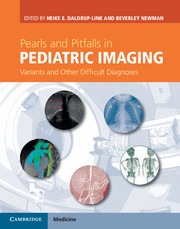Book contents
- Frontmatter
- Contents
- List of contributors
- Preface
- Acknowledgment
- Section 1 Head and neck
- Section 2 Thoracic imaging
- Section 3 Cardiac imaging
- Section 4 Vascular and interventional
- Section 5 Gastrointestinal imaging
- Section 6 Urinary imaging
- Section 7 Endocrine - reproductive imaging
- Case 67 Pediatric Graves’ disease
- Case 68 Thyroglossal duct cyst
- Case 69 Thyroid colloid cyst
- Case 70 Adrenal hemorrhage
- Case 71 Neuroblastoma
- Case 72 Ovarian torsion in childhood
- Case 73 Torsion of the appendix testis
- Case 74 Intratesticular neoplasms
- Section 8 Fetal imaging
- Section 9 Musculoskeletal imaging
- Index
- References
Case 69 - Thyroid colloid cyst
from Section 7 - Endocrine - reproductive imaging
Published online by Cambridge University Press: 05 June 2014
- Frontmatter
- Contents
- List of contributors
- Preface
- Acknowledgment
- Section 1 Head and neck
- Section 2 Thoracic imaging
- Section 3 Cardiac imaging
- Section 4 Vascular and interventional
- Section 5 Gastrointestinal imaging
- Section 6 Urinary imaging
- Section 7 Endocrine - reproductive imaging
- Case 67 Pediatric Graves’ disease
- Case 68 Thyroglossal duct cyst
- Case 69 Thyroid colloid cyst
- Case 70 Adrenal hemorrhage
- Case 71 Neuroblastoma
- Case 72 Ovarian torsion in childhood
- Case 73 Torsion of the appendix testis
- Case 74 Intratesticular neoplasms
- Section 8 Fetal imaging
- Section 9 Musculoskeletal imaging
- Index
- References
Summary
Imaging description
An 11-year-old child was found to have a palpable thyroid nodule as an incidental finding on routine clinical examination. The child was asymptomatic and thyroid function tests including thyroid hormone levels and thyroid stimulating hormone (TSH) were normal. An outside ultrasound study raised concern for a malignant thyroid nodule and the patient was referred for ultrasound-guided fine-needle aspiration for cytology. A pre-biopsy repeat ultrasound exam demonstrated a thyroid gland with multiple hypoechoic nodules and a dominant 4 × 3 × 1.5 mm hypoechoic cystic nodule containing multiple punctate hyperechogenic foci associated with comet tail artifact in the right lobe of the gland (Fig. 69.1). These findings are most consistent with a benign colloid cyst and not indicative of a thyroid carcinoma. The biopsy was cancelled and a follow-up ultrasound in 3 months was scheduled to assess lesion stability.
Importance
Approximately 2% of children develop solitary thyroid nodules. The majority of thyroid nodules in children are benign (85%) and approximately 15% are malignant. Follicular adenomas are the most common cause of a benign thyroid nodule. Thyroid nodules are usually evaluated by ultrasound, which characterizes the nodule as cystic, solid, or complex (contains both cystic and solid components). It is not unusual for additional thyroid nodules to be detected on ultrasound in addition to the index lesion that results in the patient referral. In one study of multinodular thyroid glands in 16 children, multiple nodules were seen on ultrasound in all subjects whereas several of the patients had only one palpable nodule. The majority of cystic thyroid nodules represent benign degenerating thyroid adenomas and purely cystic lesions rarely contain cancer. Complex thyroid nodules with both cystic and solid components increase the risk for cancer and are malignant in approximately 5% of patients. The likelihood for cancer decreases as the proportion of the nodule that is cystic increases. A solid or hypoechoic nodule with internal microcalcifications should raise a high concern for malignancy and needs to be distinguished from the echogenic foci and comet tail artifact associated with a colloid cyst (Fig. 69.1, 2). The presence of a comet tail artifact in a cystic thyroid nodule occurs secondary to microcrystals and is highly specific for a benign colloid cyst. In contrast to microcalcifications, the echogenic foci in a colloid cyst are not associated with acoustic shadowing.
Information
- Type
- Chapter
- Information
- Pearls and Pitfalls in Pediatric ImagingVariants and Other Difficult Diagnoses, pp. 289 - 290Publisher: Cambridge University PressPrint publication year: 2014
References
Accessibility standard: Unknown
Why this information is here
This section outlines the accessibility features of this content - including support for screen readers, full keyboard navigation and high-contrast display options. This may not be relevant for you.Accessibility Information
- 1
- Cited by
